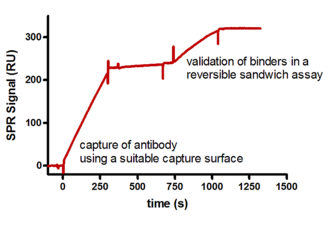PAIR-WISE EPITOPE MAPPING
Do you want to specify the epitope of a given set of antibodies?
BIA technology is ideally suited to automatically test panels of antibodies and define their epitope specificity pattern.
Binding of an antibody to an antigen defines a specific binding site or epitope which may sterically interfere with binding of another antibody which has the same or an overlapping binding site. Epitope mapping experiments are helpful to define groups of antibodies that recognize the same or overlapping binding site. These epitope families or "bins" not only target similar epitopes but often share a similar mode of action, whereas antibodies from different epitope families or "bins" are able to discriminate specific binding sites and probably use a different mode of action.
Specificity of pairs of antibodies can easily be determined by testing simultaneous binding to the antigen. Distinct binding sites can be identified by binding of both antibodies in parallel whereas an identical or closely located binding site prevents binding of the second antibody.
SPR assay formats for Epitope Mapping of Antibodies
Sandwich Assay
In a sandwich assay format, one antibody is used as analyte in solution and is tested for binding to the antigen that is first captured via another antibody immobilized to the sensor chip surface. If the antibody binds to the antigen, both antibodies (one in solution and one on the surface) recognize different, non-overlapping epitopes, whereas non-binding of antibody caused by sterical hindrance demonstrates recognition of identical or overlapping epitopes.
Tandem Assay
In a tandem assay format, the antigen is immobilized to the sensor chip surface and two antibodies are tested for binding to the antigen one after the other. If binding of the second antibody is blocked by binding of the first antibody, both antibodies recognize the same or overlapping epitopes, whereas simultaneous binding of both antibodies reveals recognition of different epitopes.
Premix Assay
In a premix assay format, the antigen is saturated with an antibody in solution, and the preformed antigen-antibody complex is tested for binding to another antibody immobilized on the sensor chip surface. If binding of the antigen to the antibody on the surface is blocked by the other, already bound antibody, both antibodies recognize the same or overlapping epitopes, whereas binding of the antigen-antibody complex to the antibody immobilized on the surface reveals recognition of different, non-over-lapping epitopes.
Our SPR service for Epitope Mapping of Antibodies
- Generation of an individual work plan for experimental setup and performance of epitope mapping experiments on a Biacore SPR instrument.
- Evaluation of SPR results documented in an electronic data presentation with figures or in a written report (optional).
Tel.: +49 (0) 561-804 4661 | Fax: +49 (0) 561-804 4665 | info@biaffin.de
We value your privacy
In order to optimize our website for you and to be able to continuously improve it, we use cookies. Further information is available in our Data Protection Statement. Here you can find our Legal Information.







